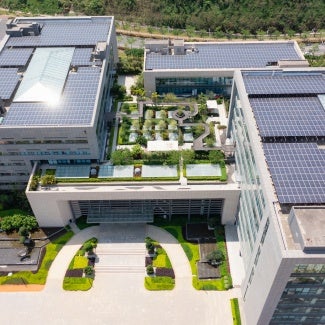Climate change adaptation design resources
Explore climate change design resources and projection tools to help buildings and communities handle and adapt to climate change effects like extreme heat and sea level rise.

Climate change resources
- Responding to Climate Change: Explore the impacts of a warming planet on buildings and communities, tools to refer to during design, and the associated adaptation and mitigation design strategies.
- Building Resilience in Boston: Best Practices for Climate Change Adaptation and Resilience for Existing Buildings: A review of national and international programs, initiatives, and activities related to improving the resilience of existing buildings to climate change impacts.
- National Climate Assessment Report: Access the projected regional impacts of climate change with a chapter specifically on the built environment, urban systems, and cities.
- Cal-Adapt: A view of how climate change might affect California with tools, data, and other resources.
- NYC Climate Resilient Design Guidelines: Explore project planning and benefit-cost analysis processes as well as design recommendations to manage extreme heat, increasing precipitation, and sea level rise.
- US Climate Resilience Toolkit: Explore scientific tools, information, and expertise to help manage climate-related risks and opportunities and improve resilience to extreme events.
- Climate Adaptation Knowledge Exchange: A knowledge sharing platform that provides case studies, tools, and resources on all phases of climate adaptation and cover local, regional, and national scales within the United States.
- Risk-Based Adaptation & Adaptation Planning Workbook: Access guidance for conducting risk-based climate change vulnerability assessments and developing adaptation action plans.
- Weather Shift: Data source for future HEAT (.epw files) and future RAIN (IDF curves and daily time-series) in a format familiar to architects and architectural engineers. The HEAT data can be used for energy simulation and thermal comfort analysis. The RAIN data can be used for rainwater harvesting and stormwater system design. Data is available for over 10,000 cities around the world through the year 2100 and is sourced from the latest IPCC global circulation models.
- Climate Change World Weather File Generator: Explore location-specific climate data files for use with building performance modeling tools.
- Climate Explorer: Get graphs, maps, and data downloads of observed and projected climate variables for every county in the contiguous United States.
- EPA CREAT Climate Scenarios Projections Map: The projection map provides changes in annual temperature and precipitation in two time periods (2035 and 2060) for three climate model projections that represent the range of projections. Note that these projections are provided to illustrate the range of potential changes in climate and no single scenario is more likely to occur than any other.
- Blistering Future Summers for 1,001 U.S. Cities: An interactive article that explores the changes in summer temperatures in U.S. cities between now and the year 2100.
- Heat and Social Inequity in the United States: A mapping tool that reveals the impacts of extreme heat. The maps combine downscaled temperature and humidity projections with socioeconomic indicators of heat vulnerability by county.
- Heatwave Guide for Cities: The guide provides information to understand, reduce the risk of, and respond to heatwaves.
- Climate Central Surging Seas: A sea level rise analysis tool.
- Climate Central Coastal Risk Screening Tool: Explore sea level rise and coastal flood risk over a period of time anywhere in the world. · NOAA Sea Level Rise Viewer: Identify the storm surge risk and impacts associated with sea level rise.
- Sea Level Rise and Nuisance Flood Frequency Changes around the United States: Access the NOAA technical report on sea level rise.
- Guidelines on Flood Adaptation for Rehabilitating Historic Buildings: Get information about how to adapt historic buildings to be more resilient to flooding risk in a manner that will preserve their historic character and meet the Secretary of the Interior's Standards for Rehabilitation.
- Blue Dunes: Climate Change by Design: A book detailing the design of artificial barrier islands developed to protect the Mid-Atlantic region of North America in the face of climate change and sea level rise.
- Centering Racial Justice in Urban Flood Adaptation: Planning and Evaluation Tools for Decision Makers and Stakeholders: A compilation of resources, including guiding principles, an interactive story map, and policy tools that aims to empower decision-makers and communities in integrating racial justice into urban planning and flood adaption in the United States.
- Georgetown Climate Center Managed Retreat Toolkit: An online tool kit that encompasses legal and policy tools, emerging practices, and case studies to support decision-making around managed retreat and climate adaptation for state, local, and territorial policymakers in U.S. coastal communities.



